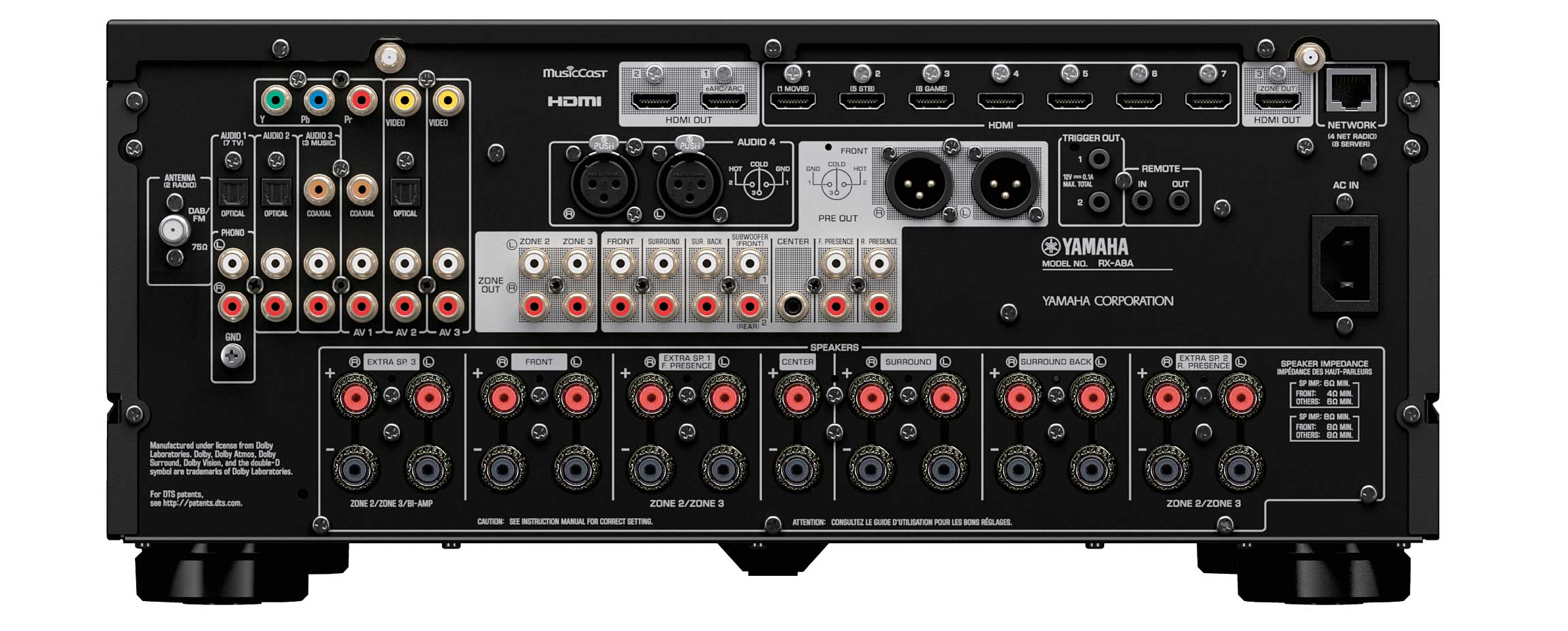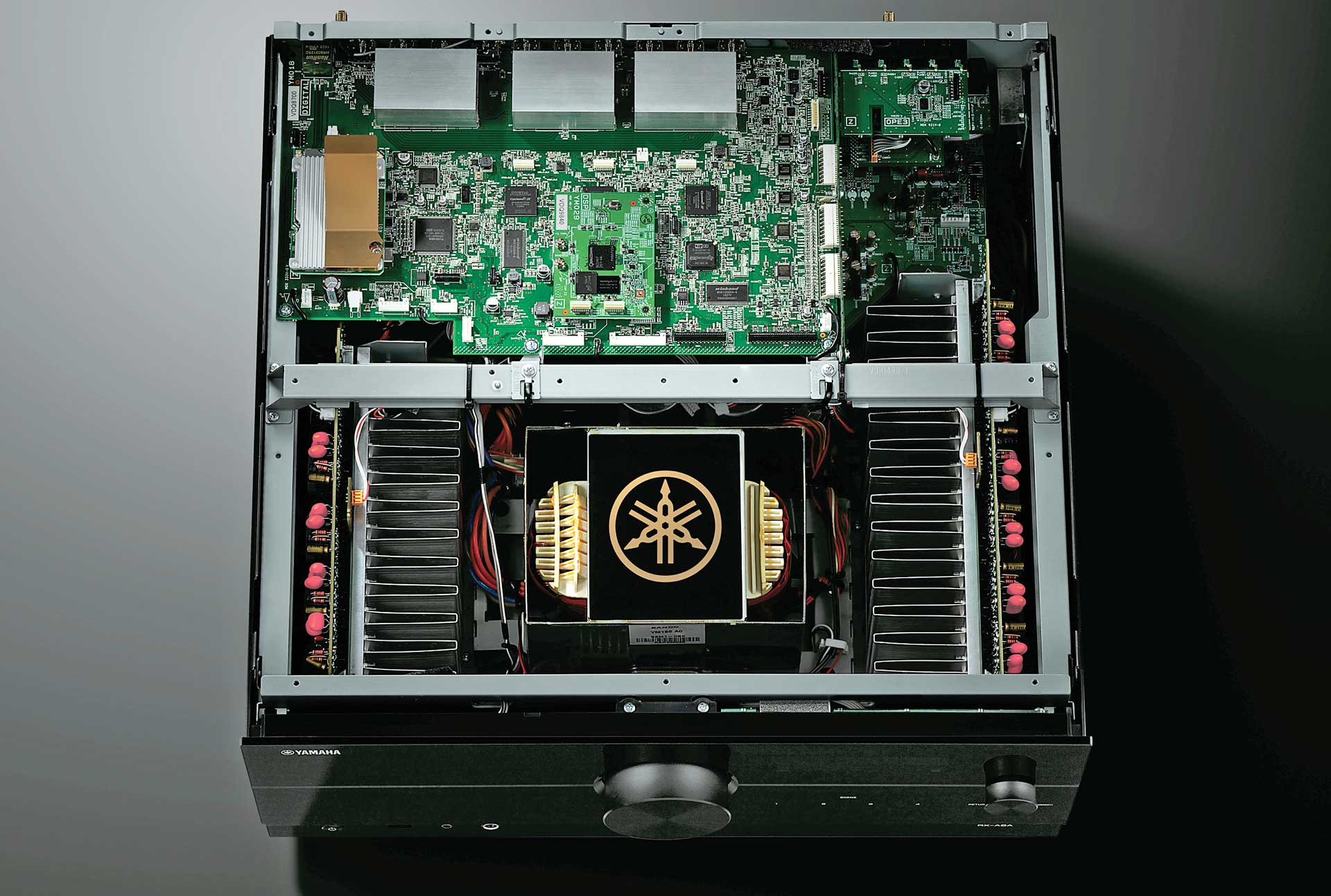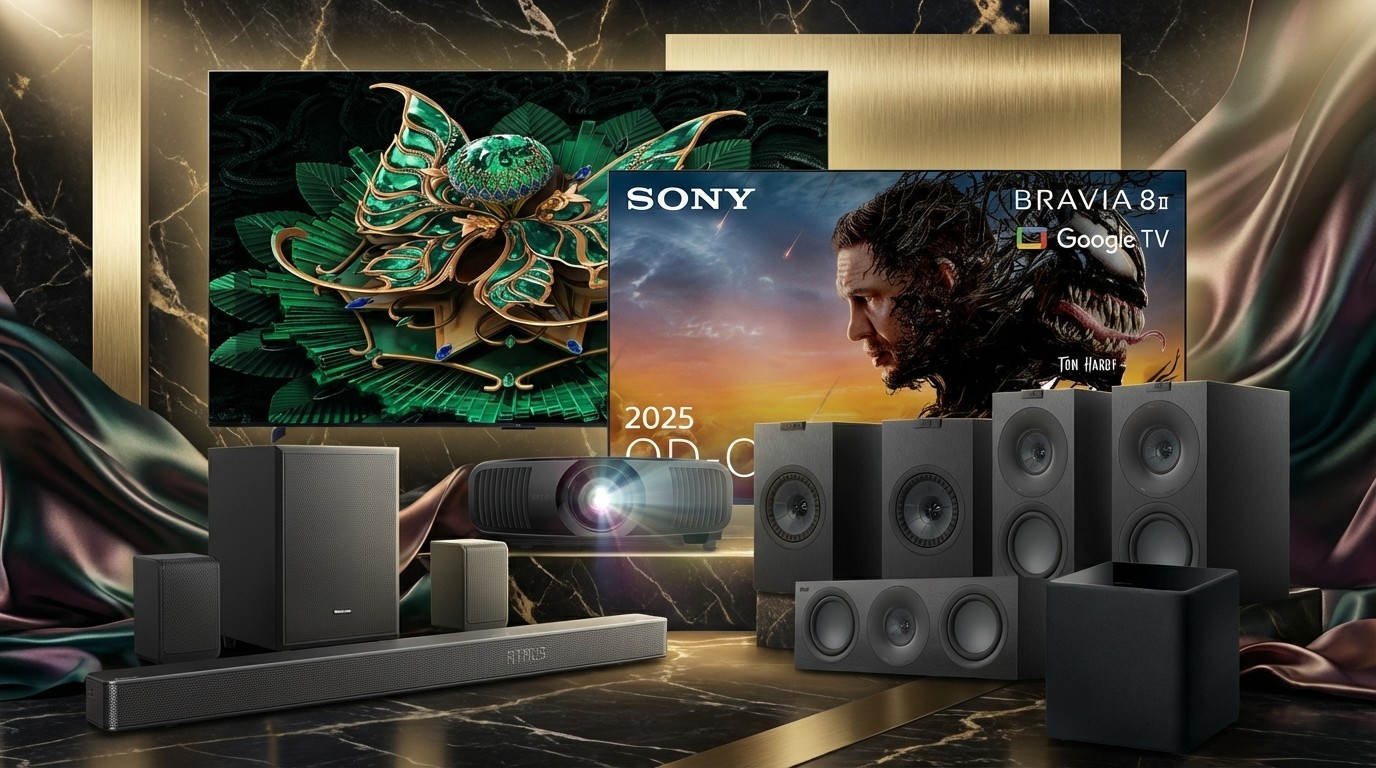Sound+Image Verdict
Yamaha’s schizophrenic attitude to overhead Atmos configurations was the only barrier to easy set-up here, and once overcome, the RX-A8A delivered superb movie sound, excellent music – especially in surround – along with extravagant versatility. It’s a worthy anniversary Aventage flagship.
Pros
- +
11 channels of Class-AB power
- +
Outstanding movie sound
- +
Excellent music performance
- +
Connectivity & versatility
- +
MusicCast built-in
Cons
- -
Set-up app needs a tweak
Why you can trust What Hi-Fi?
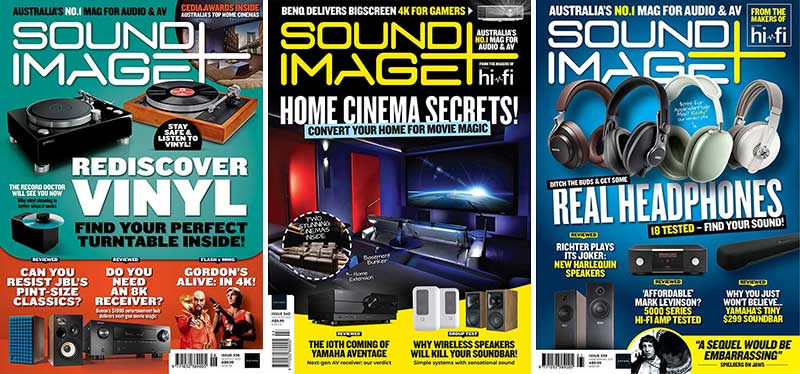
This review originally appeared in Sound+Image magazine, one of What Hi-Fi?’s Australian sister publications. Click here for more information on Sound+Image, including digital editions and details on how you can subscribe.
It’s the big one – Yamaha’s very toppermost one-box model in its latest Aventage series of AV receivers, with the company also celebrating 10 years of Aventage, or spilling into 11 years given the trials of the last 18 months. Yamaha has one of the longest track records in modern surround sound, and has consistently topped awards listings, including the Sound+Image Awards, with previous models. No pressure, then.
Inputs & layouts
The Aventage RX-A8A offers 11 channels of amplification, the first Yamaha model to do so since the RX-Z11 back in 2007 when the whole Aventage concept was still a twinkle in the eyes of its engineers. With all 11 channels and two subwoofer feeds available via pre-out sockets as well as via 13 sets of speaker outputs, that’s vast flexibility both for the main system you choose to set up, and for the ability to switch between different configurations, especially as Yamaha now allows four entirely different speaker patterns to switch between. That’s incredibly useful, especially when used in combination with Yamaha’s ‘Scene’ preset memories.
The 11 channels of power will therefore fully serve a 7.1.4. speaker layout, meaning 7-channel surround on the floor and four channels of height. If you have two subwoofers, the RX-A8A can deliver genuinely differentiated bass signals to these as either left/right or front/back, making a true 7.2.4 system.
And of course it can deliver anything less – 7.2.2, 5.1.4, down to straight stereo or 2.1. All these lesser formats will leave you with spare amplifier channels, which can be allocated in various ways. You can biamp your front stereo speakers using separate cables, assuming they are biwire/biampable with two sets of terminals. You can run speaker cables to a different zone playing stereo – two zones, in fact, if you have four channels left over. Even if you are using all the power amps for 7.1.4 you can still operate a second zone by running an additional external amp from the zone line-level outputs. There is also an additional video zone available from the RX-A8A’s third HDMI output.
The manual shows all these available layouts clearly, and also shows how to connect each speaker, which helps overcome the otherwise alarming labels on the various speaker outputs (for example the pair labelled “Extra Sp 3: ZONE 2/ZONE 3/BI-AMP”).
Intending to simplify set-up still further, Yamaha now has an app for iOS and Android called ‘AV Set-Up Guide’. This not only helps with the speaker layout, but also gets all your sources connected.
For these you have available seven HDMI inputs, all 4K 40Gbps capable, plus ‘legacy’ video inputs that are converted to HDMI output: one component video with a choice of RCA analogue or coaxial digital audio, and two composite video inputs, one with a choice of analogue or optical audio in, the other just analogue. The RX-A8A has a main HDMI output with eARC to play audio from a connected TV, a second HDMI output which has no ARC or HDMI control, and that third HDMI output mentioned earlier for an additional zone.
The latest hi-fi, home cinema and tech news, reviews, buying advice and deals, direct to your inbox.
In addition, there are five audio-only inputs – one optical digital, one for either optical or RCA analogue, one for either coaxial digital or RCA analogue, a pair of balanced XLR inputs (there are also XLR preouts for front left and right output channels), and finally a phono input for a turntable, with earthing post. In addition to Ethernet, trigger and IR connections, there’s a DAB+/FM antenna connection (and tuners within, of course), while on the front is a headphone socket. The only USB-A slot is also on the front, somewhat inconvenient if you want to permanently connect a hard drive of music files, say, but handy for plugging in a quick stick. There is no USB-B connection for computer replay.
Also within is Yamaha’s MusicCast streaming and multiroom platform, offering both control and many streaming delights.
We are so used to setting up receivers manually that we did so, using the Yamaha’s on-screen menus and the full-size back-illuminated remote control to set the speaker pattern, the distances to each speaker and our usual level tweaks. It was an easy and effective process. We did investigate Yamaha’s AV Set-Up app, but currently it has no mention of Atmos or overhead speaker layouts. Instead it sticks with Yamaha’s longstanding use of ‘Presence’ speakers, which go 1.8 metres high on the front wall, and on the rear wall if you’re using four of them.
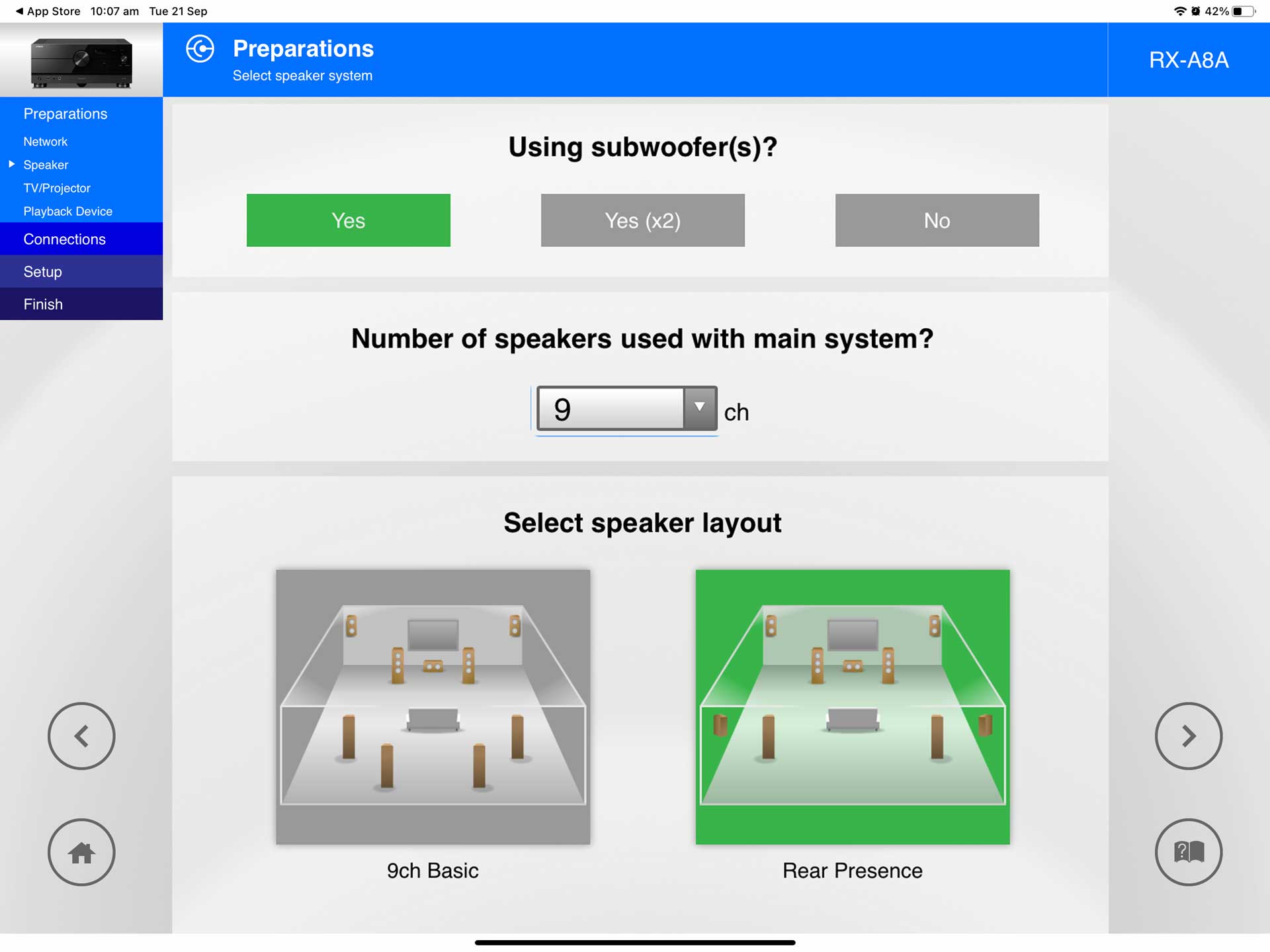
In the manual also, Yamaha treats overhead speakers as rather a second-class concept, instead repeatedly advising the use of presence wall speakers for Dolby Atmos and DTS:X playback. Dolby disagrees, of course, instead advising the use of ceiling speakers positioned either 10 degrees forward of the listening position for two, or 45 degrees in front and behind for four.
In manual set-up you can switch Yamaha’s presence speakers to ‘overhead’ use; the app currently doesn’t allow that change, though you could choose a front/rear wall presence layout and go in manually to change them afterwards. Overhead Atmos is surely what most people buying the 11-channel RX-A8A will be wanting (and we note that Yamaha sells ceiling speakers in its surround packages), so we were glad to hear that Yamaha in Australia has now requested that the app be updated to include overhead Atmos set-ups in the future.
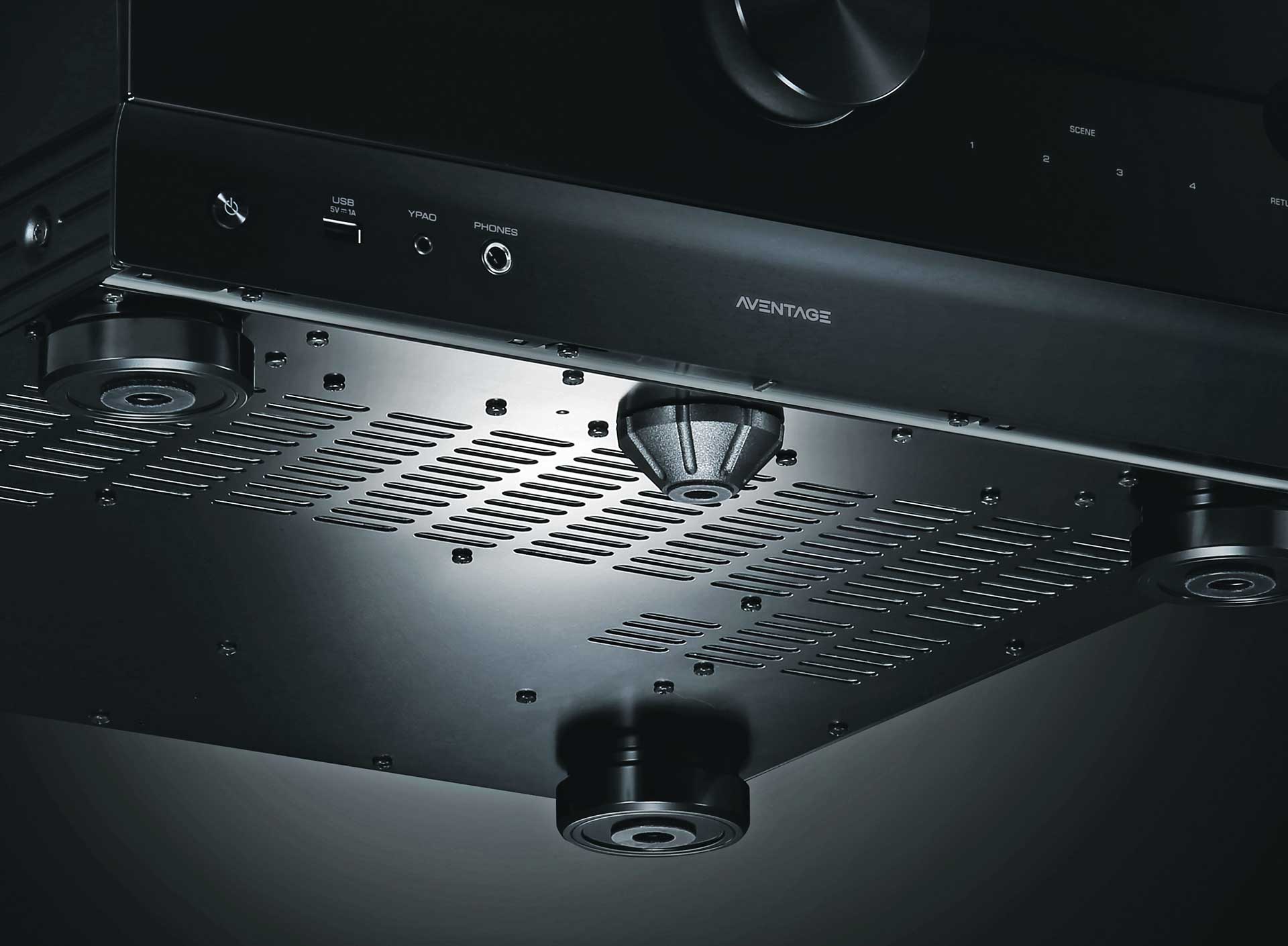
Build
One of the joys of getting a top-of-the-range receiver is the attention to detail in build quality. This model shares the overall restyling that has taken place across the Aventage 10 receivers, also on its latest RX-V models, with the main volume knob now dead centre and larger, so it’s more tempting to use. Gone is the wide central display with endless small lights and logos; gone is the big flap hiding front inputs and controls. A smaller input selector sits to the right, joined by four Scene buttons which instantly recall a preferred set-up scenario (there are in fact eight Scene memories, with the other four directly selectable using the remote control).
One visual surprise is the lack of metal on show; even Yamaha admits the new design looks less rigid, with its glossy front and perforated ABS plastic cover on top. But in fact the RX-A8A is double the weight of the A2A, and gains key elements inherited from the pre-power CX-A5200 and MX-A5200 combo, plus some exclusive features of its own. Under that top ABS is a new perforated metal cover that provides additional cross-bracing support to the chassis, which Yamaha says doubles the structure’s rigidity from previous Aventages.
The feet are upgraded to iron on both the A6A and A8A models, while only this top model gets a new brass section added to its Anti Resonance Technology (A.R.T.) wedge – the famous fifth leg. This has previously sat underneath, at the dead centre of each Aventage receiver, and it still does on the A2A, but on the rest of the range it now moves forward to front centre, as has the large transformer within – all the result of new vibrational analysis, says the company. A new metal transformer support is now one of five metal parts dedicated to dispersing any vibrations through the chassis.
A peer at the internals shows a collection of new chips sitting on a four-layer PCB that itself includes a discrete layer for power and ground, allowing these to be available anywhere on the board rather than requiring complex path design. The new processor is a single Qualcomm quad-core QCS407 with almost seven times the processing power of those in previous models.
On the audio side this top model is the only one with ESS ES9026PRO DACs handling all channels (on the A6A those presence channels get the lesser DAC used on the A4A), while symmetrical signal paths reduce crosstalk which, along with low-noise low-impedance design, goes toward Yamaha’s goal of ‘True Sound’ and accurate tonal balance.
The amplification itself is quoted at 150W per channel into 8 ohms full-range with two channels driven and 0.06% THD, also quoted with various other criteria up to 220W into 8 ohms at 1kHz, one channel driven, allowing 10% THD. Yamaha makes much of doubling the slew rate compared to the previous generation, so that it now matches the MX-A5200 power amplifier, a benefit especially for high-resolution performance, and the capacitor reserves grow with each model, to 22,000μF in the A8A.
There are also two transformer windings on this model, with separated wiring for the current amplification part (presumably the output stage) and the voltage amplification part (presumably the input stage). Those are the only clues to the actual amplification class used here, as Yamaha doesn’t specify. Our money was on some form of Class-AB, partly because of the transformer size, but mainly because it sounds like it, and Yamaha confirmed this with us just before press.

Listening
We listened in 5.1.4 and 5.1.2, both before and after YPAO room correction (it made little difference to our manual settings) and the RX-A8A never put any of its five feet wrong with Atmos soundtracks, nor with 5.1 and 7.1 soundtracks, which can be very effectively upscaled for height by the excellent ‘Surround: AI’ option. Paddington 2 would otherwise have been a bit disappointing in height terms (he is, of course, rather a small bear), as despite the Dolby Atmos label on the box, when you load it, it’s ‘Atmos 7.1’. But this was a good example of the expanded field delivered by ‘Surround: AI’ upscaling; it sounded entirely natural and brought the full speaker set into play.
The Return of the King’s defence of Osgiliath scene was a far better Atmos work-out – the Nazgul attacks swooped behind, above left, over to the right, and the Yamaha’s steering was impeccable, making these swoops a single sonic motion, not effects from separate speakers.
Jumanji is an even wilder ride with a full Atmos system adding to the adventure, from more swooping, pterodactyls this time, and a tracking bass workout for ‘The Mighty Roar’. If nothing rattles during that, your subwoofer ain’t loud enough or your installation is impressively solid. The Yamaha again delivered a cohesive soundfield whether at reference levels or below.
It even reveals, as with a good hi-fi, less than perfect mixes. Some of the effects panning in Star Trek: Beyond is as clunky as its plotting; there are some fine atmospherics, and the tannoy in the space port is nicely lifted by overhead speakers, but ships travelling on screen are sometimes panned along the sides, which feels unnatural. As with hi-fi, it’s a sign of a good system that this is made clear. For maximum assured purity, by the way, keep full-channel mixes in Straight mode, or better in Pure Direct. This was still more of a clarifying process when we moved to music, and particularly with some surround music.

Music listening
The MusicCast module in this receiver brings Spotify, Tidal, Qobuz, Amazon and Deezer, along with non-subscription streams like internet radio. During run-in we played plenty of stereo music at varying levels, and it’s a sign of the quality of the amps here that while we weren’t being transported to bliss as reliably as with our reference stereo power amps, we didn’t much miss them either.
We also found ourselves straying into All-Channel Stereo deliberately at times, something we’ve hitherto discouraged (and we still object when it arrives by default). But with all those amps and speakers, it seems churlish to use only two. The question is how to expand music to more channels without destructive effects from the processing. The All-Channel Stereo solution is pretty good in this regard, and you’re compensated by more power and a room filled with music.
Yamaha’s longstanding sound fields certainly alter the sound significantly more, yet we were further persuaded by the utility and enjoyment available from them. As mentioned in our recent A2A review, we’ve spent 30 years firmly opposed to even the concept of sticking a carefully-crafted recording through an effects box, however true-to-life Yamaha’s soundfields may be. With the A2A we had been surprised to rather enjoy some of the options, and with the A8A even more so, perhaps from the effect of the better DACs and additional available channels.
There are 11 modes listed as suitable for music content, and we tried to match music style to environment, so we selected ‘Cellar Club’ to listen to a single (yes, the vinyl things that go round at 45rpm) of Dr Feelgood doing She’s A Wind-Up, and then to a digital file of Thin Lizzy at the BBC doing She Knows. In tonal terms the ‘Cellar Club’ acoustic warmed things up in a satisfying and solidifying way, and threw a chunk of high-frequency hi-hat from the rears. It’s this spatial expansion that makes it worth the use – the timing of the rear bounce and the spread of the height speakers created what really was recognisably the effect of Dr Feelgood playing down there on a stage to the front while we listened from further back in a larger space.
In some respects it’s unrealistically perfect, since any real cellar club would have far worse acoustics, probably an inadequate PA and a load of people making noise. It would be interesting if Yamaha added the sound of drunken patrons and occasional glasses smashing to complete the mood. But somehow our brain was able to accept it, and live within it.
For this to work at all, mind you, we needed to be absolutely dead blooming plumb centre, fixing the surround system in position like a pair of headphones, with mere inches of movement available before the sound from the rear speaker ceased to be reflection of the hi-hat and just sounded like a mush of noise. Hence these ‘Programs’ are not effects to engage for a party – use all-channel stereo if you must, but don’t throw your guests into an empty cellar bar. But used privately, heck, why not. We successfully put Paul Simon and Joni Mitchell (separately) in a ‘Warehouse Loft’, Hall & Oates in the ‘Roxy Theatre’ (surely not Parramatta?). It’s disconcerting when you stop a track in the middle and the echo – lingers on.
Playing with soundfields is also best when playing whole albums, as there’s a good chance the next band along won’t fit the same acoustic. The Police sounded a bit swamped when playing in the Roxy, Sting’s vocals pushed back and soft (though not half as bad as they sounded in Telstra Stadium in 2008). The most reliable space expander for our money was ‘Standard’.
Besides, if it’s space you want, work out a way to play actual Atmos music from one of the services which provide it – notably Tidal and Apple. We strove to play from an Apple Music subscription: we connected a MacBook Air by HDMI, used the Audio-Midi utility to send 7-channel audio via HDMI, but it’s a whole lot easier from an AppleTV 4K. Aside from some curated playlists and featured albums linked from Apple’s websites, it’s pretty hard to find the stuff: Apple’s advice is to “play a track and see if the Atmos symbol comes up” – i.e. guess and good luck.
But once found, some of it sounds spectacular. Kraftwerk’s ‘3D’ album is downright hilarious. The synths on the surround mix of Tom Sawyer by Rush are fizzy enough to clean your carpet. There’s ‘Sgt. Pepper’, ‘Abbey Road’, ‘All Things Must Pass’ and soon ‘Let It Be’ all as genuine Atmos mixes, and the Harrison solo tracks are significantly more enjoyable than the new stereo remix, indeed – which, as Michael Fremer notes, “zeroes in on the trees, but completely loses the forest”.
In contrast the Atmos version is so far distinguished from the original that you’re less likely to make the comparison. Apple Scruffs, for one, just leaps to life in Atmos.
And don’t neglect the legacy of surround music available from disc. If you’re yet unconvinced by the joys of surround music, just play the DTS 24/96 surround DVD of The Beatles ‘Love’, the soundtrack to the Vegas Cirque du Soleil show, with Yamaha’s Pure Direct on. Then email us with a thank you.
Conclusion
Not only is the Aventage RX-A8A a top-class receiver for functionality and performance, it can get better. There are Winbond Field Programmable Gate Array chips dotted around the circuit board which allow far more functionality to be changed than a simple firmware update to the processor. MusicCast gets regular updates, as will the set-up app (hopefully).
On the immediate roadmap are 8K/60A, 4K/120A and HDR10+ support, with 8K/60B, 4K/120B and gaming VRR, ALLM, QFT, QM to come in the unspecified future. With an exceptional warranty of five years plus five more on registration, you should have many years to enjoy them.
Yamaha’s schizophrenic attitude to overhead Atmos configurations was the only real barrier to easy set-up, but once overcome, the RX-A8A delivered superb movie sound, excellent music – especially in surround – along with extravagant versatility. It’s a worthy anniversary Aventage flagship.
- Best home theatre speaker systems 2021

SPECIFICATIONS
Power: 11 x 150 watts (8 ohms, 20-20,000Hz, 0.06% THD, two channels driven)
Inputs: 7 x HDMI, 1 x HDMI eARC, 1 x component video, 2 composite video, 1 x balanced XLR audio, 5 x analogue line-level, 1 x phono, 3 x optical digital, 2 x coaxial digital (some audio inputs are shared), 1 x USB-A, Ethernet, Wi-Fi, Bluetooth (SBC, AAC), DAB+/FM tuners, AirPlay 2, MusicCast
Outputs: 3 x HDMI, 11-channel pre-out, XLR balanced L/R, 2 x differentiated subwoofer out, 13 pairs speaker binding posts 11 channels), 1 x 6.5mm headphone, Bluetooth (SBC)
Zone: 2 additional stereo audio, 1 HDMI AV
Other: YPAO in, remote in/out, trigger in/out
Dimensions (whd): 435 x 192 x 477mm
Weight: 21.4kg
Sound+Image is Australia's no.1 mag for audio & AV – sister magazine to Australian Hi-Fi and to the UK's What Hi-Fi?, and bestower of the annual Sound+Image Awards, which since 1989 have recognised the year's best hi-fi and home cinema products and installations. While Sound+Image lives here online as part of our group, our true nature is best revealed in the print magazines and digital issues, which curate unique collections of content each issue under the Editorship of Jez Ford, in a celebration of the joys that real hi-fi and high-quality AV can bring. Enjoy essential reviews of the most exciting new gear, features on Australia's best home cinemas, advice on how to find your sound, and our full Buying Guide based on all our current and past award-winners, all wrapped up with the latest news and editorial ponderings. Click here for more information about Sound+Image, including links to buy individual digital editions and details on how best to subscribe.
